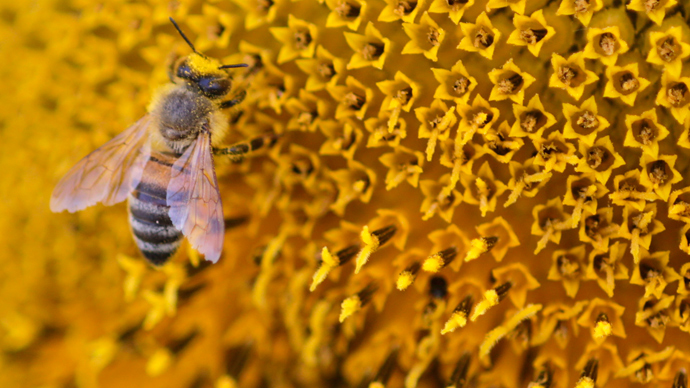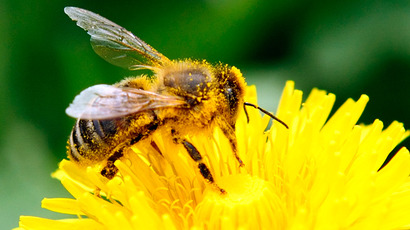Starving hives: Pesticides cause bees to collect 57% less pollen, study says

Bees exposed to "field-realistic" doses of insecticides gather less than a half the pollen that they normally do, dooming their young to starvation, UK researches have said. While some scientists hailed the findings, pesticide makers remained unimpressed
In a spin-off of their earlier study, a team of British scientists have revealed how the neurotoxic chemicals contained in agricultural neonicotinoids affect the very basic function of the honeybees – the gathering of pollen, or flower nectar.
“Pollen is the only source of protein that bees have, and it is vital for rearing their young. Collecting it is fiddly, slow work for the bees and intoxicated bees become much worse at it. Without much pollen, nests will inevitably struggle,” explained University of Sussex professor Dave Goulson, who has led the study. His comments were made in a statement released alongside the research.
Goulson’s latest paper called “Field realistic doses of pesticide imidacloprid reduce bumblebee pollen foraging efficiency” was published at the end of January in peer-reviewed journal Ecotoxicology.
The scientists exposed some of the studied bees to low doses of imidacloprid and tracked their movement with the help of electronic tags. Unexposed bees were also tracked, and each insect flying out and returning to a hive was weighed to find out the amount of pollen it gathered.
It turned out that bees exposed to the neonicotinoid brought back
pollen from only 40 percent of their trips asopposed to 63
percent of useful trips which their “healthy”
counterparts undertook.
Intoxicated bees cut the amount of pollen gathered by nearly a
third - overall, the comparative study showed that the hives
exposed to the pesticide received 57 percent less pollen.
“Even near-infinitesimal doses of these neurotoxins seem to be enough to mess up the ability of bees to gather food. Given the vital importance of bumblebees as pollinators, this is surely a cause for concern,” Hannah Feltham of the University of Stirling, another member of the research team, stated.
For bees themselves, the cut appeared to represent a sharp decline in the amount of food that the hive’s population received.
Feltham believed the study adds “another piece to the jigsaw” of why the bees have been in sharp decline lately.
Three types of controversial neonicotinoids have been temporarily banned in the European Union after the European Food Safety Authority carried out peer review of several studies showing that widely-used pesticides could harm the bees’ populations.
“It is unclear what will happen when the [EU ban] expires, as the agrochemical companies that produce them are in a legal dispute with the EU over their decision. Our new study adds to the weight of evidence for making the ban permanent,” Goulson said.
But the dispute over the role of pesticides in the so-called Colony Collapse Disorder (CCD), or mass extinction of bees, is far from being over, the reaction to the study has shown.
“This is a very important study, because it provides further detail on how bumblebee foraging is made less efficient by exposure to imidacloprid at these levels,” said Lynn Dicks, an ecologist at the University of Cambridge.
However, she then questioned the “field-realistic” dose of chemical used by the UK scientists in their study.
“The [levels in this study], particularly the pollen level, are at the upper end of what is found in the field, and likely to be higher than what bumblebee colonies are actually exposed to, because they don’t feed exclusively on oilseed rape,” Dicks argued.
Pesticide manufacturers appeared to be even more dismissive of the study’s results, comparing it to a practice of force-feeding in laboratory conditions.
“It would appear the bumble bees are essentially force-fed relatively high levels of the pesticide in sugar solutions, rather than allowing them to forage on plants treated with a seed treatment. Real field studies, such as those being initiated this autumn in the UK will give more realistic data on this subject,” Julian Little, a spokesman for major German imidacloprid producer Bayer AG has said.
Whether such open-field tests could provide a more balanced data is another issue the researchers have been arguing over. Some say that properly controlled field trials are difficult to conduct, as neonicotinoids have been widely used and bees range over wide areas to gather pollen.














